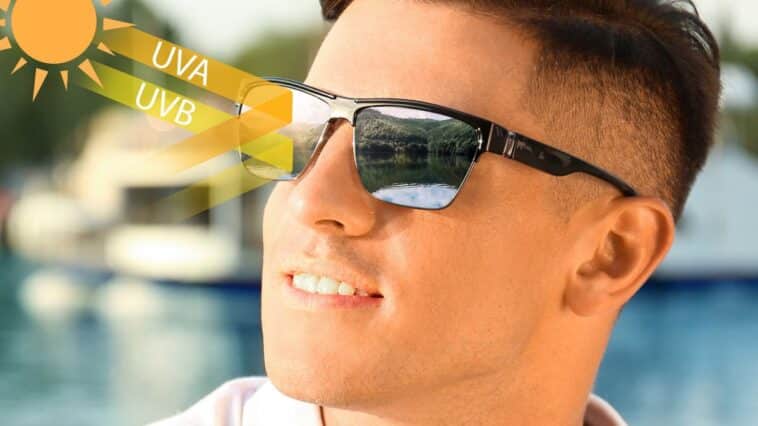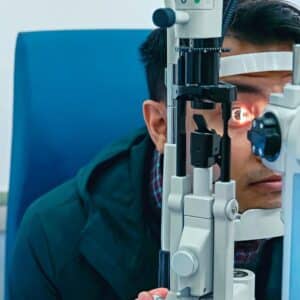The best UV protection for sunglasses is 100% protection from both UVA and UVB rays. The numbered rating on the sunglasses determines the level of UV protection. The highest UV protection rating is UV 400, which blocks wavelengths up to 400 nanometers and provides nearly 100% protection from harmful ultraviolet light rays.
Choosing sunglasses that block 99% to 100% of UVA and UVB rays is essential. This high level of sun protection can help reduce the risk of developing eye conditions such as macular degeneration, cataracts, and photokeratitis.
When shopping for sunglasses, looking for a pair clearly labeled as having UV 400 or 100% protection from UV rays is essential. However, it is important to note that lens color or tint does not necessarily indicate the level of UV protection. Therefore, it is best to take your sunglasses to an optical store and have an optician run a simple test to determine the level of UV protection.
It is also important to note that children are at greater risk for eye damage from the sun’s rays, as the lenses inside their eyes are more transparent than those of adults. Therefore, ensuring children wear sunglasses with adequate UV protection outside is crucial.
How Good is UV Protection on Polarized Sunglasses?
Polarized sunglasses are designed to reduce glare and improve visibility, especially in high-glare environments like water and snow. However, not all polarized sunglasses offer the same level of UV protection.
While polarized lenses are excellent at reducing glare, they don’t necessarily block harmful UV rays. That’s why many polarized sunglasses come with UV protection as well.
The good news is that high-quality polarized sunglasses with UV protection offer excellent protection against glare and UV rays. These sunglasses are often labeled UV 400 protection, meaning they block out 99 to 100% of UVA and UVB rays.
It’s important to note that not all polarized sunglasses come with UV protection. Cheaper polarized sunglasses, in particular, may not offer adequate protection against harmful UV rays. To ensure that your sunglasses provide adequate protection, look for a pair clearly labeled as having UV 400 protection or 100% protection from UV rays.
So, while polarized sunglasses are great for reducing glare and improving visibility, they should always be paired with adequate UV protection to keep your eyes safe and healthy.
What UV Level Should Sunglasses Be?
Regarding UV protection for sunglasses, the higher the UV level, the better the protection. The American Academy of Ophthalmology recommends choosing sunglasses that block 99% to 100% of UVA and UVB rays, and the highest UV protection rating offered is UV 400.
UV 400 protection lenses block wavelengths up to 400 nanometers, providing nearly 100% protection from harmful ultraviolet light rays. They also screen out 75% to 90% of visible light from the sun, penetrating the Earth’s atmosphere and reaching your skin and eyes through UVA and UVB rays.
Therefore, to ensure the best UV protection for your eyes, you should opt for sunglasses labeled UV 400. While lower-rated sunglasses may still provide some protection, they are less effective than those with higher ratings.
It’s important to note that the level of UV protection has nothing to do with the color or darkness of the lenses. Tinted or dark lenses may provide comfort in bright sunlight but do not necessarily offer better UV protection than clear lenses. Therefore, it’s essential to always look for the UV protection rating when choosing sunglasses.
Why UV protection is important?
Protecting your eyes from UV exposure is essential, even on cloudy days. UV protection is essential because exposure to the sun’s harmful ultraviolet (UV) radiation can cause various eye and skin problems, including eye strain, cataracts, macular degeneration, photokeratitis, and skin cancer. UV radiation in sunlight can reflect off surfaces such as water, sand, snow, and pavement.
UV radiation can penetrate the eye and damage delicate tissues, leading to long-term eye problems. Studies have shown that prolonged UV exposure can increase the risk of developing eye conditions such as cataracts, macular degeneration, and photokeratitis, a painful eye condition similar to sunburn.
UV exposure can also damage the skin around the eyes, leading to premature aging and an increased risk of skin cancer. The skin around the eyes is particularly thin and sensitive, making it more vulnerable to damage from UV radiation.
Children are especially at risk for UV damage, as their developing eyes are more sensitive to UV radiation than adults. Experts estimate that up to 80% of a person’s lifetime exposure to UV radiation occurs before age 18. That’s why it’s essential to protect children’s eyes from UV exposure by ensuring they wear sunglasses with proper UV protection.
Overall, UV protection is essential for maintaining good eye health and preventing eye and skin problems caused by prolonged exposure to UV radiation. By wearing sunglasses with high levels of UV protection, you can help protect your eyes and skin from the sun’s harmful rays.
How To Know If My Sunglasses Have UV Protection?
As mentioned earlier, it is not easy to tell if your sunglasses have UV protection just by looking at them. Some sunglasses may have a tinted lens, but that does not necessarily mean UV protection. The tinted lens is designed to reduce visible light transmission, making it more comfortable to wear sunglasses in bright sunlight.
To ensure that your sunglasses have adequate UV protection, look for sunglasses labeled with UV 400 or 100% protection from UV rays. These sunglasses block up to 99% to 100% of UVA and UVB rays, the level of protection recommended by the American Academy of Ophthalmology.
If you are still determining whether your sunglasses provide adequate UV protection, you can take them to an optical store. An optician can use a special instrument called a spectrophotometer to measure the amount of UV light that passes through the lens. They will be able to tell you whether your sunglasses have the appropriate level of UV protection.
When buying new sunglasses, purchasing from a reputable retailer is essential. Any reputable retailer will provide accurate labeling on sunglasses, so you should be able to spot whether the pair you want offers maximum UV protection. It is also a good idea to check the manufacturer’s website or packaging to see if they advertise their sunglasses as having UV protection.
Summary
It is essential to wear sunglasses with proper UV protection to prevent eye damage from harmful UV rays. The highest level of protection is provided by sunglasses labeled UV 400, which block wavelengths up to 400 nanometers and screen out 99-100% of UVA and UVB rays.
Polarized sunglasses can also be beneficial in reducing glare, but it is crucial to ensure they also have proper UV protection. It can be difficult to determine if sunglasses have UV protection just by looking at them or based on the lens color, so it is recommended to have them tested by an optician or to purchase sunglasses from a reputable retailer with accurate labeling.
UV protection is vital for adults and children, as damage from UV exposure can accumulate over time and lead to various eye conditions.






